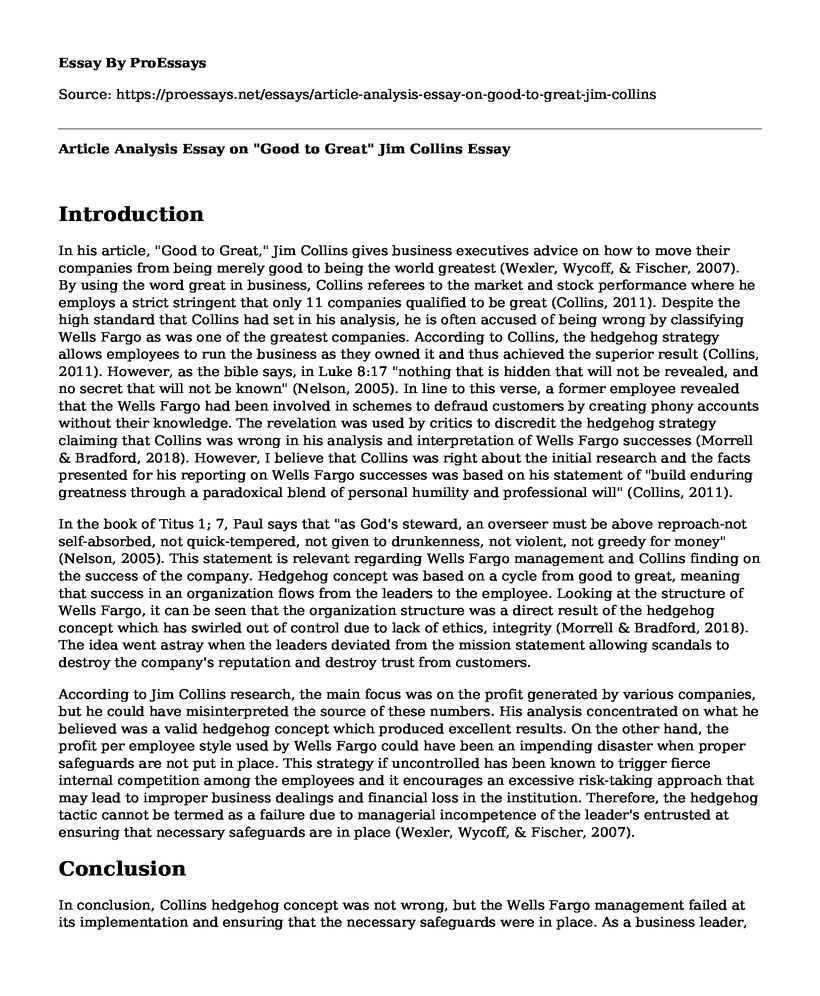Introduction
In his article, "Good to Great," Jim Collins gives business executives advice on how to move their companies from being merely good to being the world greatest (Wexler, Wycoff, & Fischer, 2007). By using the word great in business, Collins referees to the market and stock performance where he employs a strict stringent that only 11 companies qualified to be great (Collins, 2011). Despite the high standard that Collins had set in his analysis, he is often accused of being wrong by classifying Wells Fargo as was one of the greatest companies. According to Collins, the hedgehog strategy allows employees to run the business as they owned it and thus achieved the superior result (Collins, 2011). However, as the bible says, in Luke 8:17 "nothing that is hidden that will not be revealed, and no secret that will not be known" (Nelson, 2005). In line to this verse, a former employee revealed that the Wells Fargo had been involved in schemes to defraud customers by creating phony accounts without their knowledge. The revelation was used by critics to discredit the hedgehog strategy claiming that Collins was wrong in his analysis and interpretation of Wells Fargo successes (Morrell & Bradford, 2018). However, I believe that Collins was right about the initial research and the facts presented for his reporting on Wells Fargo successes was based on his statement of "build enduring greatness through a paradoxical blend of personal humility and professional will" (Collins, 2011).
In the book of Titus 1; 7, Paul says that "as God's steward, an overseer must be above reproach-not self-absorbed, not quick-tempered, not given to drunkenness, not violent, not greedy for money" (Nelson, 2005). This statement is relevant regarding Wells Fargo management and Collins finding on the success of the company. Hedgehog concept was based on a cycle from good to great, meaning that success in an organization flows from the leaders to the employee. Looking at the structure of Wells Fargo, it can be seen that the organization structure was a direct result of the hedgehog concept which has swirled out of control due to lack of ethics, integrity (Morrell & Bradford, 2018). The idea went astray when the leaders deviated from the mission statement allowing scandals to destroy the company's reputation and destroy trust from customers.
According to Jim Collins research, the main focus was on the profit generated by various companies, but he could have misinterpreted the source of these numbers. His analysis concentrated on what he believed was a valid hedgehog concept which produced excellent results. On the other hand, the profit per employee style used by Wells Fargo could have been an impending disaster when proper safeguards are not put in place. This strategy if uncontrolled has been known to trigger fierce internal competition among the employees and it encourages an excessive risk-taking approach that may lead to improper business dealings and financial loss in the institution. Therefore, the hedgehog tactic cannot be termed as a failure due to managerial incompetence of the leader's entrusted at ensuring that necessary safeguards are in place (Wexler, Wycoff, & Fischer, 2007).
Conclusion
In conclusion, Collins hedgehog concept was not wrong, but the Wells Fargo management failed at its implementation and ensuring that the necessary safeguards were in place. As a business leader, one should be astute, agile and should not be blind-sided to weaknesses in the organization (Meese, 2010). In the case of Wells Fargo, the executive should have realized that they were setting unrealistic goals which were forcing the employees to act illegally to meet these objectives. Had the leaders been proactive, they would have prevented any unethical practice aimed at the customer (Schafer, 2010).
References
Collins, J. (2011). Good to Great: Why Some Companies Make the Leap...And Others Don't. New York, NY: HarperCollins.
Meese, E. (2010). Leadership, Ethics and Policing: Challenges for the 21st Century (2nd ed.). Heritage Foundation.
Morrell, K., & Bradford, B. (2018). The public good. Policing and Public Management, 22-33.
Nelson, T. (2005). NKJV, Holy Bible, eBook. Nashville, TN: Thomas Nelson.
Schafer, J. A. (2010). Effective leaders and leadership in policing: traits, assessment, development, and expansion. Policing: An International Journal of Police Strategies & Management, 33(4), 644-663.
Wexler, C., Wycoff, M. A., & Fischer, C. (2007). "Good to Great" Policing: Application of Business Management Principles in the Public Sector.
Cite this page
Article Analysis Essay on "Good to Great" Jim Collins. (2022, Dec 13). Retrieved from https://proessays.net/essays/article-analysis-essay-on-good-to-great-jim-collins
If you are the original author of this essay and no longer wish to have it published on the ProEssays website, please click below to request its removal:
- Transformation Leadership Paper Example
- Decision Making for an International Business Essay Example
- Essay on Effective Corporate Governance: Transparency, Accountability and Risk Management
- Essay Sample on Global Workforce: The Impact of Leadership on Performance
- Paper Sample on Lean Six Sigma Method Redefined
- Essay on Ineffective Corporate Governance: The Case of Martha Stewart Living Omnimedia
- Ensuring Ethical Decision-Making: Gather the Facts - Essay Sample







